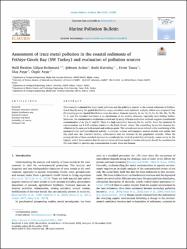Assessment of trace metal pollution in the coastal sediments of Fethiye-Göcek Bay (SW Turkey) and evaluation of pollution sources

Göster/
Tarih
2022Yazar
Gülşen-Rothmund, Halil İbrahimGülşen-Rothmund, Halil İbrahim
Arslan, Şebnem
Kurtuluş, Bedri
Tunca, Evren
Avşar, Ulaş
Avşar, Özgür
Üst veri
Tüm öğe kaydını gösterKünye
Gülşen-Rothmund, H. İ., Ş. Arslan, B. Kurtuluş, E. Tunca, U. Avşar, and Ö. Avşar. 2023. "Assessment of Trace Metal Pollution in the Coastal Sediments of Fethiye-Göcek Bay (SW Turkey) and Evaluation of Pollution Sources." Marine Pollution Bulletin 186. doi:10.1016/j.marpolbul.2022.114387.Özet
This research evaluated the trace metal pollution and the pollution sources in the coastal sediments of Fethiye-Göcek Bay by using the spatial distribution maps, correlation and statistical analysis, which were acquired from 69 sampling points. Spatial distribution maps for eleven elements (namely Al, As, Co, Cr, Cu, Fe, Mn, Mo, Ni, Pb, Ti, V, and Zn) revealed that there is an enrichment of the studied elements, especially near Fethiye harbor. Moreover, the contamination evaluation carried out by using different evaluation methods suggests considerable contamination of As, Co, Cr and Ni. There is a high correlation between Ni, Co, and Fe, Even the minimum Ni concentrations are 9 fold enriched relative to the Earth Crust's values. The controlling factors for element distribution in the area are both natural and anthropogenic. The natural sources are related to the weathering of the geological units and hydrothermal activity. In contrast, various anthropogenic sources include coal smoke, fuel oils used near the crowded harbors, urbanization and the increase in the population recently. When the ecological risk of these enriched elements is considered, the level of probability of toxicity comes out to be the highest, which demonstrates that the accumulation of trace metals in harbor sediments should be considered in the near future to prevent any contamination toward biota and human.

















